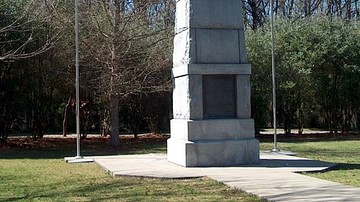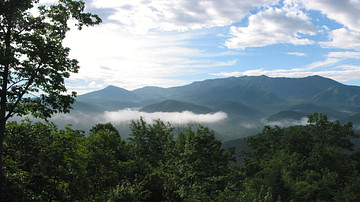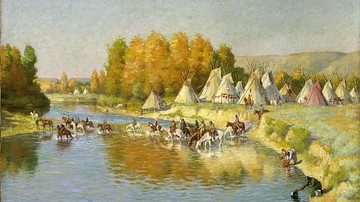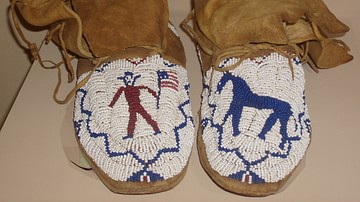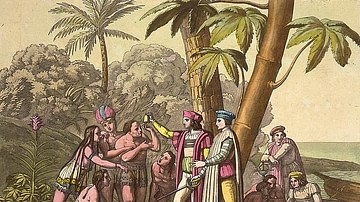The Nûñnĕ′hĭ are the Cherokee "spirit people", similar to the fairy as sometimes depicted in European medieval folklore, and The Nûñnĕ′hĭ and Other Spirit Folk is a collection of anecdotes about them compiled by American ethnographer James Mooney (l. 1861-1921) and included in his Myths of the Cherokee (1900). The Nûñnĕ′hĭ appear in many Cherokee myths and legends.
The Nûñnĕ′hĭ and Other Spirit Folk describes the entities – as well as others – and their various antics and is partly drawn from stories told by James D. Wafford, also known as Tsuskwasun'nawa'ta of the Western Cherokee nation. Wafford became a great Cherokee storyteller who collected and memorized the tales of the people and is referenced in the following text.
To a modern audience, the belief in the "Little People" may seem only a superstition, but this is a relatively new understanding when placed in the context of world history. Belief in spirits, fairies, ghosts, and other supernatural entities has been a part of the human condition far longer than the popular modern-day skepticism and cynicism. The Teihiihan ("Little people") of the Arapaho nation, as well as similar entities of other Native peoples of North America, were recognized as realities of life for centuries and still are today.
The literal truth of any of the tales of the Nûñnĕ′hĭ is never questioned, but neither is it ever vouched for, in keeping with Cherokee storytelling tradition, which follows the policy of "I know not how the truth may be/I tell the tale as 'twas told to me" (Mooney, 236). According to Mooney, however, all the following anecdotes were verified using different sources. The tales are still recited by Cherokee storytellers in the present day, and the Nûñnĕ′hĭ are still understood, as in the past, as simply another aspect of life on earth.
Text
The following text is taken from Myths of the Cherokee (1900) by James Mooney, republished in 2014 by Dover Publications.
The Nûñnĕ′hĭ or immortals, the "people who live anywhere," were a race of spirit people who lived in the highlands of the old Cherokee country and had a great many townhouses, especially in the bald mountains, the high peaks on which no timber ever grows. They had large townhouses in Pilot knob and under the old Nĭkwăsĭ′ mound in North Carolina, and another under Blood Mountain, at the head of Nottely river, in Georgia.
They were invisible excepting when they wanted to be seen, and then they looked and spoke just like other Indians. They were very fond of music and dancing, and hunters in the mountains would often hear the dance songs and the drum beating in some invisible townhouse, but when they went toward the sound it would shift about and they would hear it behind them or away in some other direction, so that they could never find the place where the dance was.
They were a friendly people, too, and often brought lost wanderers to their townhouses under the mountains and cared for them there until they were rested and then guided them back to their homes. More than once, also, when the Cherokee were hard pressed by the enemy, the Nûñnĕ′hĭ warriors have come out, as they did at old Nĭkwăsĭ′, and have saved them from defeat. Some people have thought that they are the same as the Yûñwĭ Tsunsdi′, the "Little People"; but these are fairies, no larger in size than children.
There was a man in Nottely town who had been with the Nûñnĕ′hĭ when he was a boy, and he told Wafford all about it. He was a truthful, hard-headed man, and Wafford had heard the story so often from other people that he asked this man to tell it. It was in this way:
When he was about 10 or 12 years old, he was playing one day near the river, shooting at a mark with his bow and arrows, until he became tired, and started to build a fish trap in the water. While he was piling up the stones in two long walls a man came and stood on the bank and asked him what he was doing. The boy told him, and the man said, "Well, that's pretty hard work and you ought to rest a while. Come and take a walk up the river." The boy said, "No"; that he was going home to dinner soon. "Come right up to my house," said the stranger, "and I'll give you a good dinner there and bring you home again in the morning." So the boy went with him up the river until they came to a house, when they went in, and the man's wife and the other people there were very glad to see him, and gave him a fine dinner, and were very kind to him. While they were eating a man that the boy knew very well came in and spoke to him, so that he felt quite at home.
After dinner he played with the other children and slept there that night, and in the morning, after breakfast, the man got ready to take him home. They went down a path that had a cornfield on one side and a peach orchard fenced in on the other, until they came to another trail, and the man said, "Go along this trail across that ridge and you will come to the river road that will bring you straight to your home, and now I'll go back to the house." So, the man went back to the house and the boy went on along the trail, but when he had gone a little way he looked back, and there was no cornfield or orchard or fence or house; nothing but trees on the mountain side.
He thought it very queer, but somehow, he was not frightened, and went on until he came to the river trail in sight of his home. There were a great many people standing about talking, and when they saw him they ran toward him shouting, "Here he is! He is not drowned or killed in the mountains!" They told him they had been hunting him ever since yesterday noon and asked him where he had been. "A man took me over to his house just across the ridge, and I had a fine dinner and a good time with the children," said the boy, "I thought Udsi′skală here"—that was the name of the man he had seen at dinner—"would tell you where I was." But Udsi′skală said, "I haven't seen you. I was out all day in my canoe hunting you. It was one of the Nûñnĕ′hĭ that made himself look like me." Then his mother said, "You say you had dinner there?" "Yes, and I had plenty, too," said the boy; but his mother answered, "There is no house there—only trees and rocks—but we hear a drum sometimes in the big bald above. The people you saw were the Nûñnĕ′hĭ."
Once, four Nûñnĕ′hĭ women came to a dance at Nottely town and danced half the night with the young men there, and nobody knew that they were Nûñnĕ′hĭ, but thought them visitors from another settlement. About midnight they left to go home, and some men who had come out from the townhouse to cool off watched to see which way they went. They saw the women go down the trail to the river ford, but just as they came to the water they disappeared, although it was a plain trail, with no place where they could hide. Then the watchers knew they were Nûñnĕ′hĭ women.
Several men saw this happen, and one of them was Wafford's father-in-law, who was known for an honest man. At another time a man named Burnt-tobacco was crossing over the ridge from Nottely to Hemptown in Georgia and heard a drum and the songs of dancers in the hills on one side of the trail. He rode over to see who could be dancing in such a place, but when he reached the spot the drum and the songs were behind him, and he was so frightened that he hurried back to the trail and rode all the way to Hemptown as hard as he could to tell the story. He was a truthful man, and they believed what he said.
There must have been a good many of the Nûñnĕ′hĭ living in that neighborhood, because the drumming was often heard in the high balds almost up to the time of the Removal.
On a small upper branch of Nottely, running nearly due north from Blood Mountain, there was also a hole, like a small well or chimney, in the ground, from which there came up a warm vapor that heated all the air around. People said that this was because the Nûñnĕ′hĭ had a townhouse and a fire under the mountain. Sometimes in cold weather hunters would stop there to warm themselves, but they were afraid to stay long. This was more than sixty years ago, but the hole is probably there yet.
Close to the old trading path from South Carolina up to the Cherokee Nation, somewhere near the head of Tugaloo, there was formerly a noted circular depression about the size of a townhouse, and waist deep. Inside it was always clean as though swept by unknown hands. Passing traders would throw logs and rocks into it, but would always, on their return, find them thrown far out from the hole. The Indians said it was a Nûñnĕ′hĭ townhouse, and never liked to go near the place or even to talk about it, until at last some logs thrown in by the traders were allowed to remain there, and then they concluded that the Nûñnĕ′hĭ, annoyed by the persecution of the white men, had abandoned their townhouse forever.
There is another race of spirits, the Yûñwĭ Tsunsdi′, or "Little People," who live in rock caves on the mountain side. They are little fellows, hardly reaching up to a man's knee, but well-shaped and handsome, with long hair falling almost to the ground. They are great wonder workers and are very fond of music, spending half their time drumming and dancing. They are helpful and kind-hearted, and often when people have been lost in the mountains, especially children who have strayed away from their parents, the Yûñwĭ Tsunsdi′ have found them and taken care of them and brought them back to their homes.
Sometimes their drum is heard in lonely places in the mountains, but it is not safe to follow it, because the Little People do not like to be disturbed at home, and they throw a spell over the stranger so that he is bewildered and loses his way, and even if he does at last get back to the settlement, he is like one dazed ever after. Sometimes, also, they come near a house at night and the people inside hear them talking, but they must not go out, and in the morning, they find the corn gathered or the field cleared as if a whole force of men had been at work. If anyone should go out to watch, he would die. When a hunter finds anything in the woods, such as a knife or a trinket, he must say, "Little People, I want to take this," because it may belong to them, and if he does not ask their permission, they will throw stones at him as he goes home.
Once a hunter in winter found tracks in the snow like the tracks of little children. He wondered how they could have come there and followed them until they led him to a cave, which was full of Little People, young and old, men, women, and children. They brought him in and were kind to him, and he was with them some time; but when he left, they warned him that he must not tell or he would die. He went back to the settlement and his friends were all anxious to know where he had been. For a long time, he refused to say, until at last he could not hold out any longer, but told the story, and in a few days he died. Only a few years ago two hunters from Raventown, going behind the high fall near the head of Oconaluftee on the East Cherokee reservation, found there a cave with fresh footprints of the Little People all over the floor.
During the smallpox among the East Cherokee just after the war one sick man wandered off, and his friends searched, but could not find him. After several weeks he came back and said that the Little People had found him and taken him to one of their caves and tended him until he was cured.
About twenty-five years ago a man named Tsantăwû′ was lost in the mountains on the head of Oconaluftee. It was wintertime and very cold and his friends thought he must be dead, but after sixteen days he came back and said that the Little People had found him and taken him to their cave, where he had been well treated, and given plenty of everything to eat except bread. This was in large loaves, but when he took them in his hand to eat, they seemed to shrink into small cakes so light and crumbly that though he might eat all day he would not be satisfied. After he was well rested, they had brought him a part of the way home until they came to a small creek, about knee deep, when they told him to wade across to reach the main trail on the other side. He waded across and turned to look back, but the Little People were gone and the creek was a deep river. When he reached home his legs were frozen to the knees and he lived only a few days.
Once the Yûñwĭ Tsunsdi′ had been very kind to the people of a certain settlement, helping them at night with their work and taking good care of any lost children, until something happened to offend them, and they made up their minds to leave the neighborhood. Those who were watching at the time saw the whole company of Little People come down to the ford of the river and cross over and disappear into the mouth of a large cave on the other side. They were never heard of near the settlement again.
There are other fairies, the Yûñwĭ Amai′yĭnĕ′hĭ, or Water-dwellers, who live in the water, and fishermen pray to them for help. Other friendly spirits live in people's houses, although no one can see them, and so long as they are there to protect the house no witch can come near to do mischief.
Tsăwa′sĭ and Tsăga′sĭ are the names of two small fairies, who are mischievous enough, but yet often help the hunter who prays to them. Tsăwa′sĭ, or Tsăwa′sĭ Usdi′ga (Little Tsăwa′sĭ), is a tiny fellow, very handsome, with long hair falling down to his feet, who lives in grassy patches on the hillsides and has great power over the game. To the deer hunter who prays to him he gives skill to slip up on the deer through the long grass without being seen. Tsăga′sĭ is another of the spirits invoked by the hunter and is very helpful, but when someone trips and falls, we know that it is Tsăga′sĭ who has caused it. There are several other of these fairies with names, all good-natured, but more or less tricky.
Then there is De′tsătă. De′tsătă was once a boy who ran away to the woods to avoid a scratching and tries to keep himself invisible ever since. He is a handsome little fellow and spends his whole time hunting birds with blowgun and arrow. He has a great many children who are all just like him and have the same name. When a flock of birds flies up suddenly as if frightened it is because De′tsătă is chasing them. He is mischievous and sometimes hides an arrow from the bird hunter, who may have shot it off into a perfectly clear space but looks and looks without finding it. Then the hunter says, "De′tsătă, you have my arrow, and if you don't give it up, I'll scratch you," and when he looks again, he finds it.
There is one spirit that goes about at night with a light. The Cherokee call it Atsil′-dihye′gĭ, "The Fire-carrier," and they are all afraid of it, because they think it dangerous, although they do not know much about it. They do not even know exactly what it looks like, because they are afraid to stop when they see it. It may be a witch instead of a spirit. Wafford's mother saw the "Fire-carrier" once when she was a young woman, as she was coming home at night from a trading post in South Carolina. It seemed to be following her from behind, and she was frightened and whipped up her horse until she got away from it and never saw it again.


